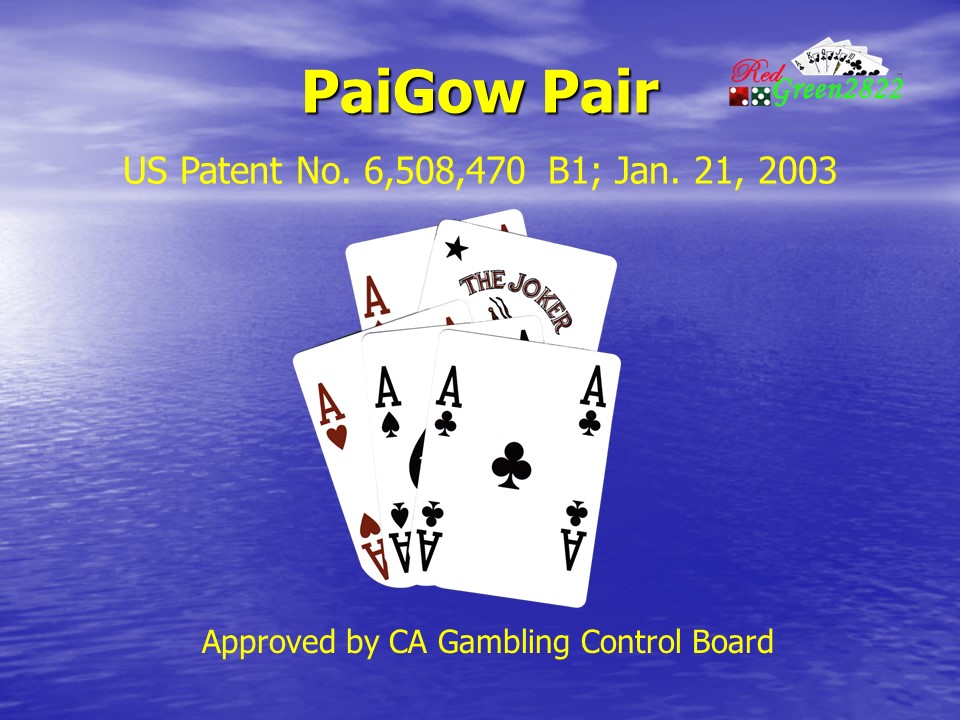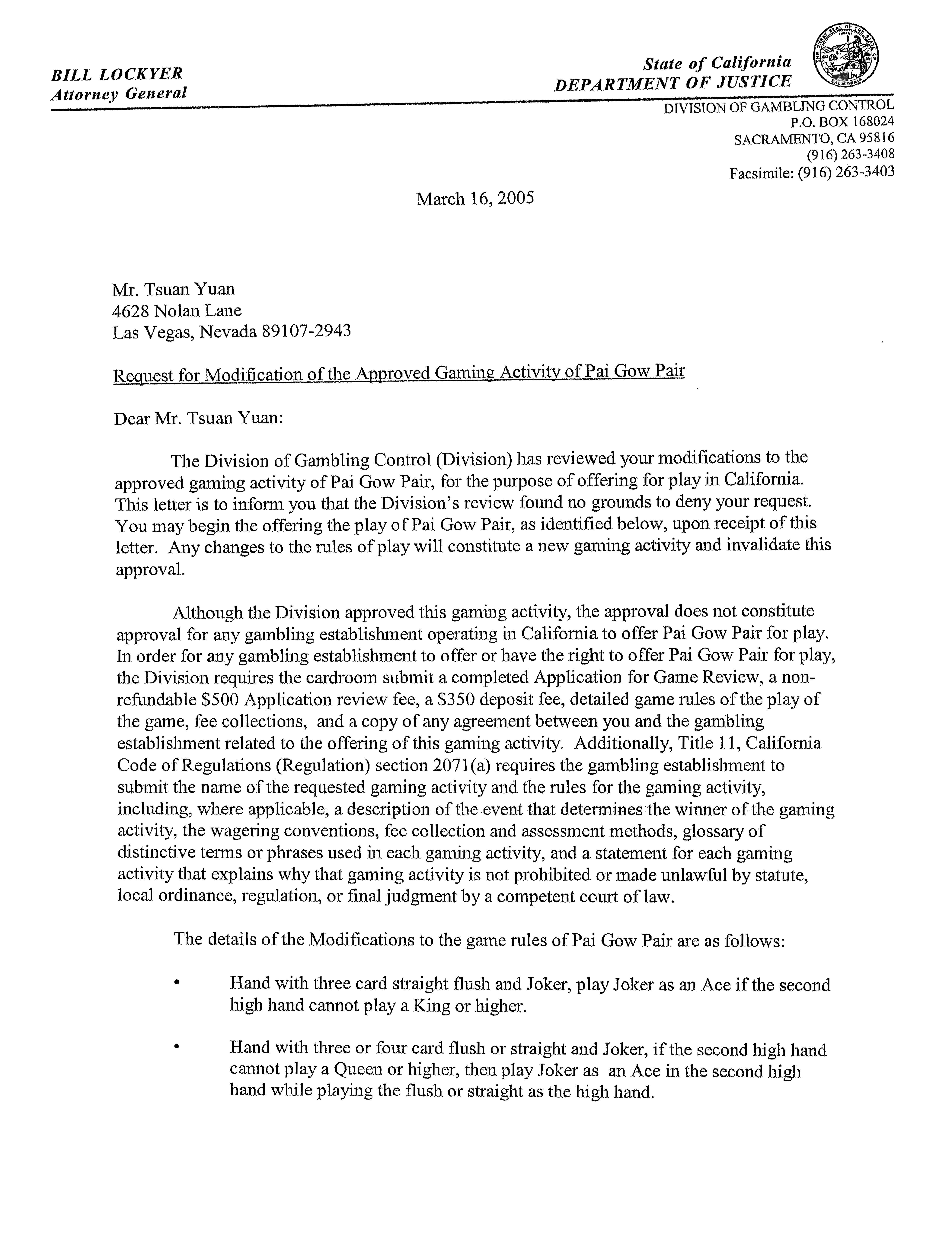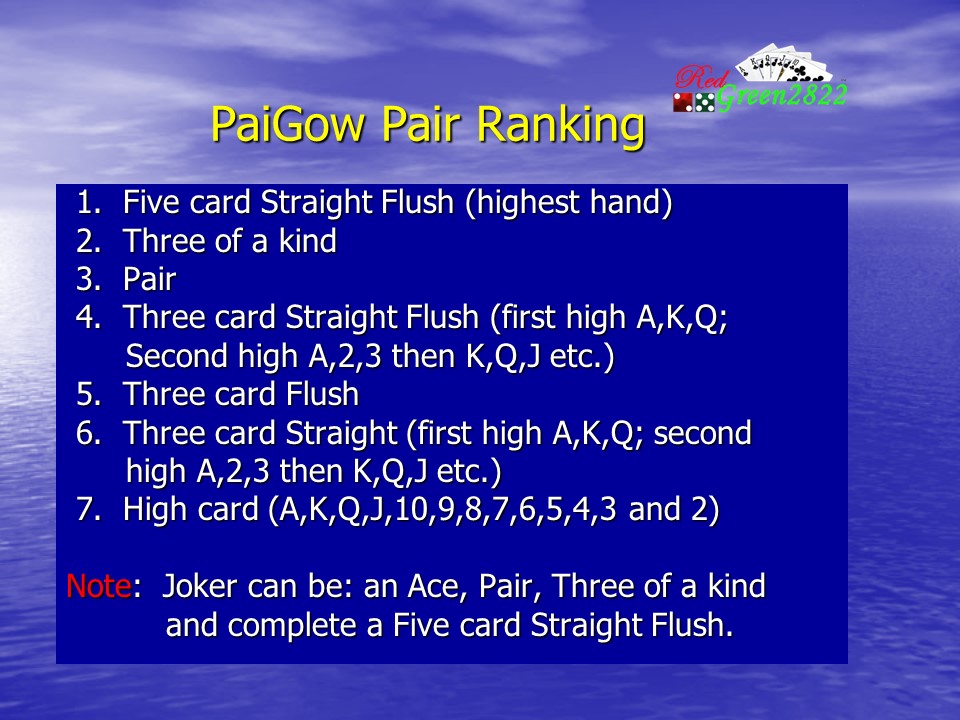PaiGow Pair
Table Sign
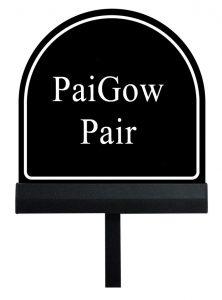
Layout
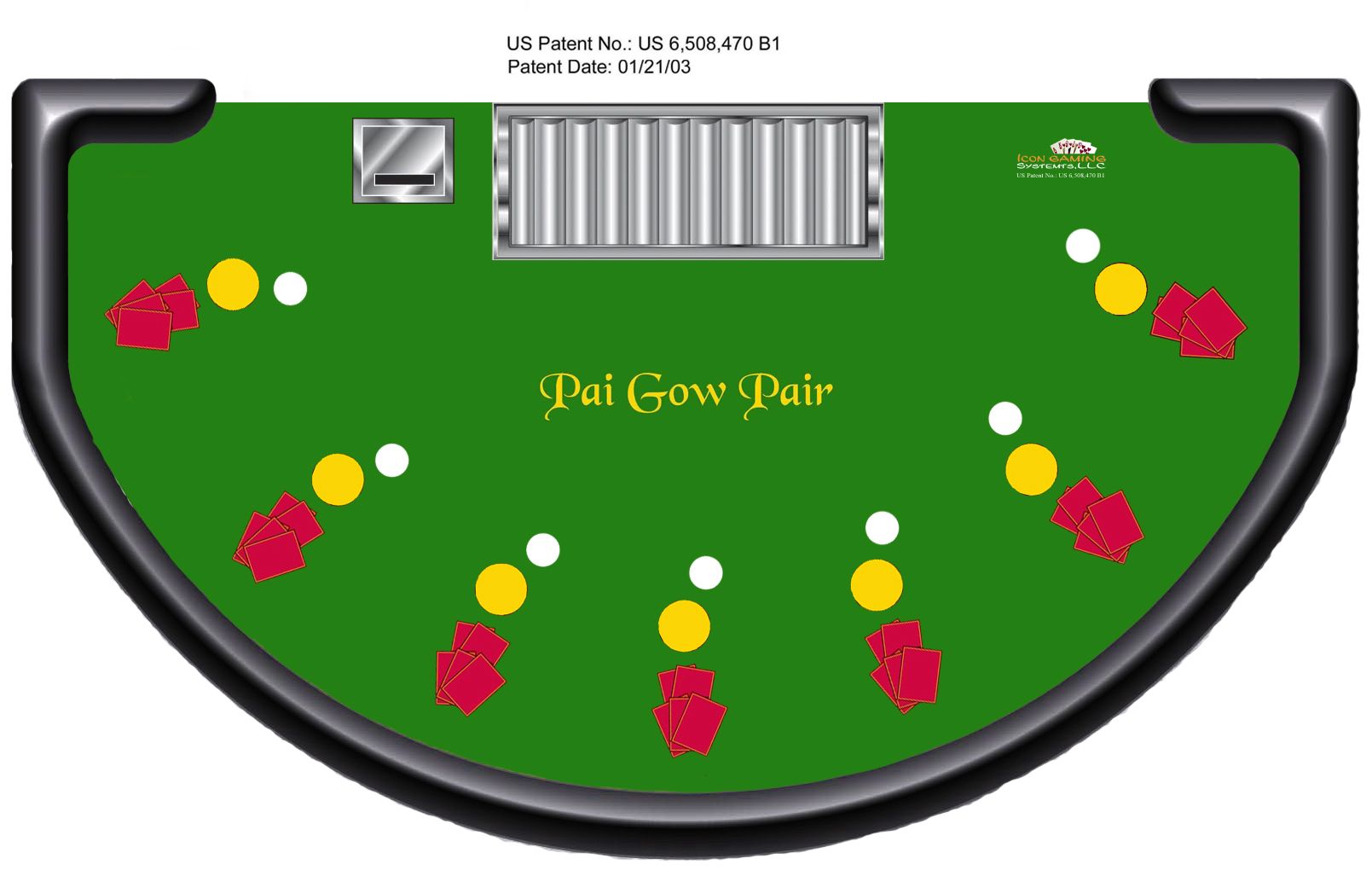
PLAYING RULES
PaiGow Pair is a fun and easy game, it plays a pair and a pair, if a player receives a pair in his/her hand, he/she will keep it as a pair without thinking about the flush or straight except pair of Ace or King. It is a new variation of Pai Gow Poker; this game is played using conventional Poker playing cards, namely a single 52-card deck with a Joker. Pai Gow Poker plays with seven cards and plays two hands simultaneously, a two card hand and a five card hand. This game PaiGow Pair is also played two hands simultaneously, but instead it plays a two card hand (second high) and a three card (high hand). The Joker in this game can be any wild card in the hand. The players may set their hand with the Joker as they wish. But the Player-Dealer has to follow the House rules below to set his/her hand. To avoid setting a foul hand, the Player-Dealer is allowed to use the Joker to substitute for any other card to avoid a foul hand setting. Joker is best used to make any pair a three of a kind, or any card a pair, it should be an Ace in the two card hand (second high) when a hand contains a three card low straight flush, three or four card low flush and straight. The Joker also could be used to complete a five card straight flush (highest hand).
Ranking:
- Five card straight flush (highest hand) special hand.
- Three of a kind
- Pair
- Three card straight flush. (first high Ace, K and Q, second high Ace, 2 and 3 then K, Q and J etc.)
- Three card flush.
- Three card straight. (first high Ace, K and Q, second high Ace, 2 and 3 then K, Q and J etc.)
- High card (Ace, K,Q,J,10,9,8,7,6,5,4,3, and 2)
House Rule:
-
- Five card straight flush: Automatic win or highest special hand (House option).
- Always play five card straight flush, place five cards face down together at the hand area.
- Three of a kind: Always play three of a kind as high-hand except three of a kind Aces, Kings and Queens.
- Always split three of a kind of Aces, play pair of Aces at high hand (bottom hand) and the other Ace at second high hand (top hand).
- Always split three of a kind of Kings, play pair of Kings at high hand (bottom hand) and the other King at second high hand (top hand), if the second high hand doesn’t have an Ace.
- Always split three of a kind of Queens, play pair of Queens at high hand and the other Queen at second high hand, if the second high hand doesn’t have a King or Ace.
- Pair:
- One Pair – Always play pair as high-hand except pair Aces and Kings.
- Always split a pair of Aces if the second high hand doesn’t have Jacks or higher. For example: Play A♥8♥ – A♣10♣5♦ instead of 10♣8♥ – A♥A♠5♦. Play pair if second high hand is a Jack or higher. For example: Play J♥8♣ – A♠A♦5♠.
- Always split pair of Kings if the second high hand doesn’t have a Jack or higher and if it can complete a three card flush. For example: Play K♥7♦ – K♣ 8♣ 4♣ instead of 8♣7♦ – K♥K♣4♣. Play pair if you can not make the high hand a three card flush. For Example: Play 8♥7♦ – K♠ K♣ 4♥.
- Two Pairs – Hand with two pairs, always play the higher pair at high hand and the lower pair at second high hand.
- One Pair – Always play pair as high-hand except pair Aces and Kings.
- Four of a kind:
- Hand with four of a kind of 4’s or lower (A) if the fifth card is an Ace then play three of a kind at high hand and the other card with an Ace at second high hand, (B) if the fifth card is not an Ace then split four of a kind into two pairs, play Pair at high hand and the other pair at second high hand.
- Hand with four of a kind of 5 or higher, split four of a kind into two pairs, play pair at high hand and the other pair at second high hand.
- Straight Flush, Flush and Straight:
- Hand with low three card straight flush, flush or straight, play straight flush, flush or straight if the second high hand can play with a 10 or higher. (try to play two high hands, if not play high hand high)
- Hand with higher three card straight flush, flush or straight such as below: (a) A♥ K♥ Q♥ or K♣ Q♣ J♣, (b) A♦ K♦ Any ♦ or K♥ Q♥ Any ♥, (c) A ♣ K♦ Q♣ or K♠ Q♠ J♥. Don’t play straight flush, flush or straight, play second high card and the third high at second high hand, while the first high card, the fourth and the fifth at the high hand.
- High card (nothing):
- Hand with nothing, play the second high card and the third high at second high hand, while the first high card, the fourth and the fifth at the high hand.
- Joker Wild Cards: It is total wild, it can be anything.
- Hand with nothing, play the first high and second high card at the two card second high hand then play the Joker with the third high card as a pair and the fourth card at the three card high hand. For example: Hand with J♥, 10♣, 8♦, 4♠ and Joker, play J♥ 10♣ at the second high hand, while play the Joker with an 8♦ as a pair of 8’s and 4♠ at the high hand.
- Hand with one pair, play the Joker as a higher pair as possible, if it can not play as a higher pair then play it as a lower pair. For example, (1) hand has J♥,10♣, 10♠, 8♦ and a Joker, play 10♣,10♠ at the second high hand while the Joker play with J♥ as a pair of J’s and 8♦ at the high hand. (2) Hand has Q♣, Q♥, 8♦, 3♠ and Joker, play Joker with an 8♦ as a pair of 8’s at the second high hand, while Q♣, Q♥ and 3♠ at the high hand.
- Hand with two pairs, always play the higher pair at the second high hand, while the lower pair plays with the Joker as a three of a kind at the high hand. For example, hand has J♥, J♣, 8♦, 8 ♣ and a Joker, play J♥, J♣ at the second high hand, while play the Joker with 8♦, 8 ♣ as a three of a kind of 8’s at the high hand.
- Hand with three card straight flush and a Joker, play Joker as an Ace if the second high hand can not play a King or higher. For example, (1) hand with Q♥, J♥, 10♥, 7♥ and Joker, play Joker as an Ace with 7♥ at second high hand, while Q♥J♥10♥ at high hand instead of Q♥J♥ at second high and Joker as a pair of 10’s and 7♥ at high hand. (2) K♥,10♥,9♥,8♥ and Joker, play K♥ 10♥ at second high hand, while Joker as a pair of 9’s and 8♥ at high hand.
- Hand with three or four card flush or straight and Joker, if the second high hand can not play a Queen or higher, then play Joker as an Ace at the second high hand and play flush or straight at high hand. For example, (1) hand with 7♣,8♥,9♣,10♥ and Joker, play the Joker as an Ace with 10♥ at second high hand then play 7♣,8♥,9♣, at high hand. (2) hand with 4♣, 5♠, 6♠,Q♠ and Joker, play Q♣ and 6♠ at second high hand while the Joker as a pair of 5’s and 4♣ at high hand.
- Joker can be used to complete a five card straight flush. Hand with four cards straight flush and Joker, always play five cards straight flush as an automatic win or as highest special hand.
- Full house:
- Hand with full house, always split full house, play pair at second high hand and three of a kind at the high hand.
- Five card straight flush: Automatic win or highest special hand (House option).
Dealing Procedure
A House Dealer deals hands to each Player and the Player-Dealer. At least two Players and one House Dealer are involved. The dealing procedure is as follows: the House Dealer shuffles a Poker playing card deck consisting of 52 cards plus only one Joker, a Player cuts the deck and the Player-Dealer shakes the dice. The House Dealer deals eight sets of five cards in front of him/herself, the first card will start from the House Dealer’s left to right then from right to left until eight sets of five cards are dealt. The Player-Dealer will point at one of eight sets of five cards (is the first set) for the House Dealer to distribute, then the House Dealer will hand the dice cup which contains three dice to the Player-Dealer to shake. The total of three dice determines which Player or the Player-Dealer will receive the first set of five cards and also determines the Action-Button location. The Player-Dealer’s positions are 1, 9 and 17. The Player and the Player-Dealer are numbered in counter-clockwise fashion according to their locations. The location assigned the number rolled receives the first set of five cards in sequence from the Player-Dealer’s right to left. The other set of five cards are distributed in sequence to the players and the Player-Dealer in counter-clockwise order, player positions at which no wager has been placed may or may not receive a set of five cards according to the House policy. In the former case, any set of five cards distributed to a player position without a wager are removed from the play. No other cards are dealt during game play.
The House may have the choice to deal this game by any method according House policy, or such as below:
- Player-Dealer shakes the dice, the House Dealer deals the first card (one in turn by hand dealing) to the position of the Action-button in counter-clockwise direction, this position with or without a wager should receive the first card then skip to the next position with wagers until all the position with wagers, Player-Dealer position and the Action-Button position receive 5 cards (Player-Dealer and the action button position must receive a set of five cards). House Dealer deals cards in a counter-clockwise direction, starting from the Player-Dealer’s right to left. The House Dealer compares the player’s hands to the Player-Dealer hand starts from the Action-Button in the same direction (counter-clockwise).
- House may employ a shuffle machine to deal this game (same as Pai Gow Poker). House Dealer distributes five cards set at a time from the shuffle machine to the Player and Player-Dealer from the Player-Dealer’s right to left (counter-clock wise). In this method, the betting circle with or without a wager also receives a set of five cards.
Comparison
The outcomes of the Player hand vs. Player-Dealer hand.
Note: Player-Dealer wins on ties.

ANALYSIS
Pai Gow Pair is a variation of Pai Gow Poker. The game is played with a standard pack of 52 cards with no jokers on a blackjack-size table. Players have the option of making any of two bets: the Pai Gow bet and the Bonus bet. The Pai Gow bet is played against the dealer and the Bonus bet against a pay table.
Rules of Play
Play begins with each player making either the Pai Gow bet or both of the two bets. The bets need not be equal. Each player and the dealer will receive five cards face down.
Pai Gow Bet
The player should form two hands from his five cards: a two-card front hand and a three-card back hand. The two-card hand must not be stronger than the three-card hand.
The hand ranking for the three-card hand is shown below, from highest to lowest:
- Three of a kind
- One pair
- Straight flush
- Flush
- Straight (A-2-3 is the second highest straight.)
- High card
There will be no straights or flushes for the two-card hand, whose highest ranking is a pair of Aces.
When a player’s hand is compared with the dealer’s hand, both hands must be of higher ranking to win. If both are of the same value or lower, the dealer wins. If one hand is lower and the other is higher, it is a push. A 5% commission is charged on a player winning Pai Gow hand.
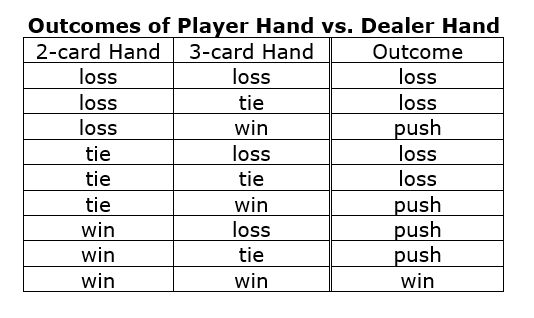
The player will not be allowed to bank.
The dealer must play the house-way strategy given below. The house strategy is not optimal; it was made simple so the dealers can commit to memory.
House-way Strategy
There are six types of five-card hands. Depending on the type of the five-card hand the dealer receives, the dealer should set his hand as follows:
Non-pair
If a straight or better cannot be formed in the back, play the best front hand. Otherwise, play the best front hand and keep a straight or better in the back. However, if the front is less than Queen-high, break the straight or better if you can put a Queen or higher in the front.
Examples:
Play Q♠J♠ – K♠8♥4♣instead of 8♥4♣ – K♠Q♠J♠.
Play Q♣9♥ – A♣4♣2♦ instead of 9♥2♦ – A♣Q♣4♣
One pair
Put the pair in the back and play the best front hand. However, if the front is less than 10-high, split a pair of Kings or Aces if you can play a straight or better in the back.
Example: Play K♥9♥ – K♣5♣2♣ instead of 9♥5♣ – K♣K♥2♣.
Two pair
Put the low pair in the front and high pair in the back.
3 of a kind
Always split 3 Aces.
Split 3 Kings if an Ace cannot be played in the front.
Split 3 Queens if the front is less than K-high.
Otherwise, put the 3 of a kind in the back.
Example: Q♦6♥ – Q♣Q♥3♠.
Full house
Put the 3 of a kind in the back and the pair in the front.
4 of a kind
Play a pair each in the front and back if it’s four 5s or greater. If it’s four 4s or less:
- play 3 of a kind in the back if an Ace can be put in the front; else,
- play a pair each in the front and back.
Bonus Side Bet
The player also has the option to make a Bonus side bet. If the player’s five-card hand matches one of the winning combinations the player wins the Bonus bet regardless of the dealer’s hand. Below are the pay tables for the Bonus bet:
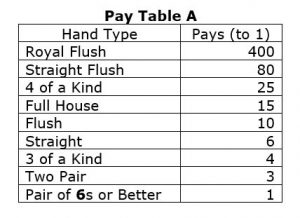
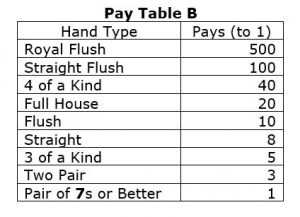
No commission is charged on a player’s winning Bonus bet.
Mathematical Analysis
There are C52,5 x C47,5 = 2,598,960 * 1,533,939 = 3,986,646,103,440 ways to deal 5 cards to a player and 5 cards to the dealer. Then each 5-card hand can be set in as many as ten ways. Therefore, in theory there will be 3,986,646,103,440 * 10 * 10 = 398,664,610,344,000 plays to examine. However, there are only 134,459 distinct 5-card hands, and not all possible plays need to be examined since some ways of setting a hand are inferior to the others.
Given the above house-way strategy and knowing that the dealer will set any given 5-card hand with no straight or flush possibilities the same way (e.g., J♣T♥–K♥8♠6♣ and J♦T♣-K♣8♥6♠), the number of 5-card dealer hands to check can be further reduced from 1,533,939 to at most 42,783 for each way of setting a player hand. Furthermore, there will be at most 138,702 ways of setting the dealer hands:
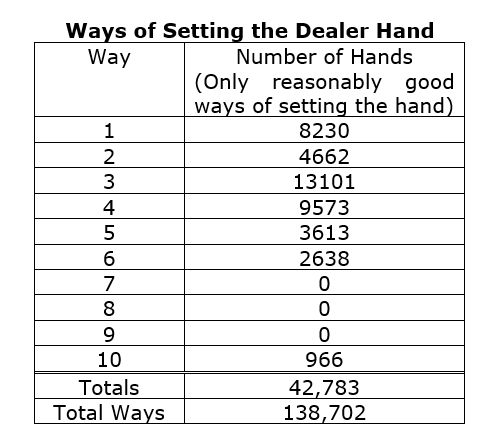
A combinatorial analysis was performed to determine the optimal player strategy. The software dealt each distinct player hand, tried all reasonably good ways of setting the hand, compared the hand with the dealer hands dealt from the remaining deck and noted down the best play and its expectation.
For example, the performance of a hand of 2♠3♥4♦5♠J♥ will vary, albeit how small the difference will be:

The player’s expectation was derived by comparing with the 1,533,939 dealer hands drawn from the remaining 47-card deck.
Overall, the player who employs the optimal strategy against the house-way strategy will win 28.933% of the time, lose 29.402% of the time, and tie 41.665% of the time, for a net loss of 1.915% of the total Pai Gow wager. The analysis shows that 1.43% of the time the house would win at least one of the two hands due to ties.
A 500-million hand computer simulation of a player using the house-way strategy against the house showed a player expectation of -2.22%.
If no commission is charged on a player winning hand, as in those games played at California card clubs wherein there is a player banker, the player banker’s advantage is 0.468%.
Bonus Bet
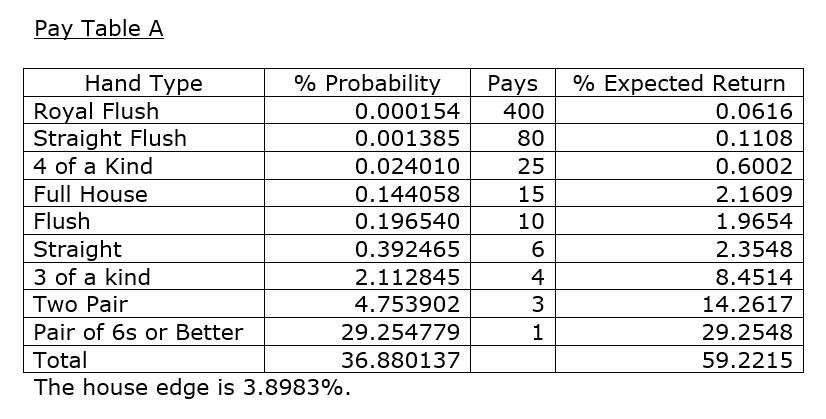
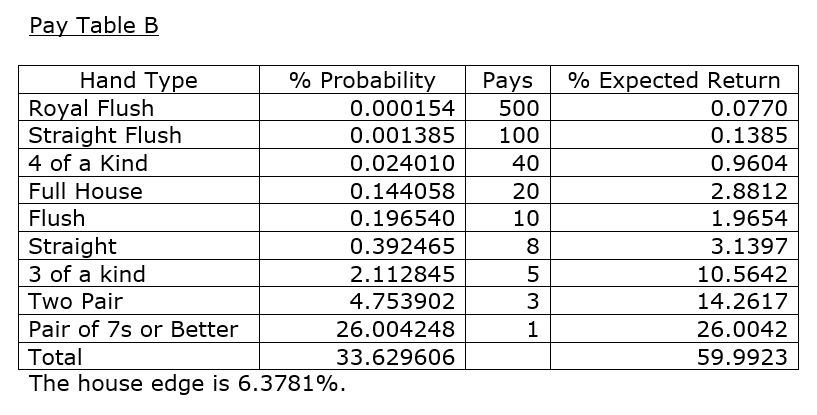
Presented By: Stanley Ko
GAMBOLOGY – PO Box 82225 – Las Vegas, NV 89180 – (702) 258-9685
October 1, 2004
